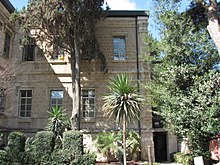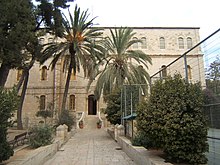Street of the Prophets

Street of the Prophets (
During its heyday in the late 19th century and early 20th century, Street of the Prophets was a favorite address for hospitals, churches, monasteries, hospices,[1] government offices, foreign consulates, and wealthy Christian, Jewish and Muslim residents.
Today the street still boasts the same heterogeneous mix of residents and workers,
Etymology
The Street of the Prophets was established during the expansion of Jerusalem beyond the walls of the Old City in the mid-19th century.[3] In the beginning, the street did not have a name. It was known as:
- "Street of the Hospitals" — due to the many hospitals, Christian and Jewish, situated along its route;
- "Street of the Consuls" — due to the many foreign consulates that opened offices here.[3][4]
The street was officially named at the beginning of the British Mandate period by the Governor of Jerusalem, Ronald Storrs.[3] At that time, the street was paved and infrastructure for water and electricity were installed.
According to one opinion, the street was named for the
Pre-1948 hospitals and Christian missions
Early on, Street of the Prophets was a popular address for hospitals, often run by confessional organisations. In the mid-19th century, the hospitals that were located in the Old City were forced to move due to high population density and difficult sanitary conditions. Each hospital re-established itself on Street of the Prophets to maintain its proximity to the residents still residing in the Old City.
Street of the Prophets was also home to
The hospitals established on Street of the Prophets in the late 19th century and early 20th century included:
- Marienstift Children's Hospital (#29), opened in 1872 by Dr. Max Sandreczky
- Italian Hospital (#34), the creation of Giulio and Antonio Barluzzi. The project was started in 1912 and the complex, containing a hospital and a church, opened in 1919.
- Meyer Rothschild Hospital (#37), the first Jewish hospital outside the Old City, built by Baron James Rothschild in 1888 and named after his father


- German Deaconess Hospital (#49, corner with Straus St.), opened in 1894. After 1948 it was taken over by Bikur Cholim Hospital as the "Ziv Building".

- Bikur Cholim Hospital (#53), built in 1910, recently closed down
- English Hospital (former), now Anglican School (#82). The hospital was opened in 18966[when?] by the London Society for Promoting Christianity Among the Jews. Across the street and a bit further north is a modern hotel, built where the English Mission had opened a sanatorium in 1862.[7]

Government offices and consulates
- Pasha's House (#61), built by the Greek Orthodox Church and rented out to the Ottoman governors of Jerusalem.[8]
- The German consulate once stood beside the International Evangelical Church on the site of present-day Raoul Wallenberg Street. It was attacked by the Israeli underground when it flew a flag with a swastika in 1933,[9] and was subsequently destroyed by the underground.[10]
- The U.S. Consulate General, founded in the Old City in 1844, relocated to an address near the beginning of Street of the Prophets in the late 19th century. In 1912, it moved to its present address on Agron Street.[11]
- Ethiopian Consulate (#38-40), built by Empress
Hotels

- Kamenitz Hotel (#65), built in 1878, was a five-star hotel with a carriage entrance from Jaffa Road.[8]
- San Remo Hotel (#70), built in 1927, occupied the three-story building on the northeast corner of Street of the Prophets and Straus Street, opposite Bikur Holim Hospital.[5]
Private homes

Unlike other areas outside the Old City which were exclusively Jewish, Christian or Arab, the Street of the Prophets was a heterogeneous zone. Ottoman and, later, British officials; foreign consuls and well-to-do residents all lived here, creating a cultural and social center.[13]
Notable residents of the street include:
- "Thabor House" (#58), the home of Conrad Schick, German Protestant missionary and architect who designed and/or built several of the buildings on the street, including his own.
- Navon Bey House (#59) was the residence of Joseph Navon, a Jewish businessman and with Johannes Frutiger initiator of the Jaffa–Jerusalem railway, from whom the former bought the house in 1885.[7][8]
- Hunt residence (#64), built in 1869 by English painter

- "Mahanaim" (34, Shivtei Yisrael Street and Street of the Prophets), built in 1885 by High Commissioner during the Mandate period.[16] Today it houses offices of the Israeli Ministry of Education.
Various communities

In the late 19th century, several Jewish neighborhoods were founded at the eastern end of Street of the Prophets, near Damascus Gate.
Beginning in the 1880s, an
Architecture

Most of the buildings on Street of the Prophets are constructed of stone and fronted by high walls built of stone and mortar. Private-home lots are large and include garden courtyards, either in front of the building (e.g. Hunt House, Navon Bey House, Mahanaim House) or behind it (e.g. Pasha's Village). The homes are one or two stories high; public buildings do not exceed four stories.
Many public and private buildings on the western side of Street of the Prophets, from Shivtei Israel Street to Davidka Square, are built in the European style and reflect the nationality of their builders. For example, the German Deaconess Hospital and its bell tower (today the eastern wing of Bikur Cholim Hospital) are typical of churches and other public buildings in Germany. Buildings and doors along the street are decorated with religious symbols such as crosses, Stars of David, crescents, symbols of religious institutes, and Bible verses.
Several buildings were designed by architect Conrad Schick: the mission of the
The

In 1898,

The former
Armenian mosaic

In 1894 a burial cave containing an ancient
New location
The two-story buildings, constructed by Muslims, currently house a health clinic
Military headquarters
During both world wars and the

In 1948, the eastern end of the street, forming a triangle with the Old City walls and the southern side of the neighborhood of Musrara, was part of the no man's land between Israel and Jordan.[1] The street was returned to Israel with the reunification of Jerusalem in 1967.
Urban development
In the late 1980s, a proposal was made to widen the narrow, two-lane street into a 32-meter-wide main road. The proposal met with stiff opposition from Jerusalem residents, as it called for destroying the historic garden courtyards of the buildings lining the street. An alternate plan called for laying the highway across the courtyards while retaining the outer stone walls to maintain the 19th-century look of the street. Neither plan has come to fruition.
Modern institutions
Schools
- Anglican International School (#82)[25]
- Hadassah College Jerusalem (formerly Hadassah College of Technology) (#37)[26]
- Jerusalem ORT (#42)
- Lycée Française (French School) (#66)
Hospitals
- Bikur Holim Hospital
Between 1976 and 1988, a railway coach parked a few meters east of Bikur Holim Hospital housed the national headquarters for the Yad Sarah home-care equipment lending organization.[5][27] The building at #43 Street of the Prophets still bears the organization's name.
Christian organizations

- International Evangelical Church (#55)
- St. Joseph of the Apparition Convent (#66)
- Swedish Theological Institute (#58)[28]

- Shevet Achim, an international community that brings children with congenital heart defects to the medical centers in Israel (#29)
Government offices
- Ministry of Education and Culture (Italian Hospital building)
- Ministry of Education office (Lev-Ram building)
- Ministry of Education (Mahanaim house)
Hostels
- Abraham Hostel[29]
- Palm Hostel
Memorials
- 1948 Arab-Israeli War
- Mitzpe Tomer (Tomer Observation Post) at the eastern end of the street (corner Highway 60) commemorates the spot where, in April 2002, a traveling car bomb detonated, killing 19-year-old Israeli border policeman Mordechai Tomer
References
- ^ a b "Jerusalem Strolls: Haneviim and Ethiopia St". jerusalemite.net. 2008-09-03. Retrieved 2010-07-11.
- ^ a b c "Street of the Prophets Plan". Sustainable Jerusalem Coalition. 2001. Archived from the original on 2009-07-13. Retrieved 2010-07-11.
- ^ a b c d e "Ha-nevi'im Street". Jerusalem Municipality. Archived from the original on 2011-06-17. Retrieved 2010-07-11.
- ^ ISBN 1-932687-54-8.
- ^ a b c d e f g h i j Bar Am, Aviva. "Rehov Hanevi'im — Around the houses". The Jerusalem Post. Archived from the original on 2010-12-16. Retrieved 2010-07-11.
- ^ ISBN 0-87306-879-3.
- ^ a b Eliyahu Wager (1988). English Hospital. Jerusalem: The Jerusalem Publishing House. pp. 186–187.
{{cite book}}:|work=ignored (help) - ^ a b c Bar-Am, Aviva. "A Guide to Buildings in Jerusalem". The Jerusalem Post. Archived from the original on 2012-02-24. Retrieved 2010-07-11.
- ^ Medoff, Rafael (Spring 2004). "An Unorthodox Rabbi on Capitol Hill: The legacy of Rabbi Baruch Rabinowitz" (PDF). Jewish Action. Archived from the original (PDF) on 2011-07-23. Retrieved 2010-07-11.
- ^ a b Malka, Annette (2009-08-09). "Street of the Prophets, Jerusalem". terredisrael.com. Retrieved 2010-07-11.
- ^ "About the Consulate". Consulate General of the United States/Jerusalem. 2009. Archived from the original on 2010-07-07. Retrieved 2010-07-11.
- ^ a b c d "The Ethiopian Consulate". Jerusalem Municipality. 2006-02-06. Archived from the original on 2011-06-17. Retrieved 2010-07-11.
- ^ Zaun-Goshen, Heike (2007). "Beyond the Wall - Chapters on Urban Jerusalem". The Jerusalem Post. Archived from the original on 2011-06-12. Retrieved 2010-07-11.
- ^ Gilad, Moshe (29 August 2012). "Peeking through the highrises: Famed Jerusalem street's old architectural glories". Haaretz. Retrieved 21 June 2014.
- ^ Green, Michael (2008-08-07). "Whose Property?". The Jerusalem Post. Retrieved 2010-07-11.
- ^ ISBN 978-0-7914-5919-5.
- ^ a b c Ben-Arieh, Yehoshua (1979). עיר בראי תקופה: ירושלים החדשה בראשיתה [A City Reflected in its Times: New Jerusalem – The Beginnings] (in Hebrew). Jerusalem: Yad Izhak Ben-Zvi Publications. pp. 163–165.
- ^ Robin Twite, "Die Äthiopische Kirche – Afrika in Jerusalem", Ela Moszkowicz (trl.), in: Ariel: Eine Zeitschrift zur Kunst und Bildung in Israel, vol. 102 (1996; titled: 'Jerusalem mit 3000'), pp. 40-53, here p. 50.
- ^ Gilad, Moshe (29 August 2012). "Peeking Through the Highrises: Famed Jerusalem Street's Old Architectural Glories". Haaretz. Retrieved 12 December 2022.
- ^ "Jerusalem Architectural History: The late Ottoman Period (1850 - 1917)". Jewish Virtual Library. Retrieved 12 December 2022.
- ^ "Herzl and Zionism". Israel Ministry of Foreign Affairs. 2004-07-20. Retrieved 2010-07-15.
- Empress Zaudituwhile the Empress was also visiting there. The Empress continued the construction on Ustinov's foundations. The building became the Ethiopian Consulate". (Addition in edged brackets and omissions are not in the original)
- ^ a b "מסלול טיול ברחוב הנביאים בירושלים" [Tour Route on Street of the Prophets in Jerusalem]. Yair Tiyulim. 2014. Retrieved 21 June 2014.
- ^ "Armenian Mosaic, Jerusalem". sacred-destinations.com. 2010. Retrieved 2010-07-11.
- ^ "From the Executive". aisj.co.il. Archived from the original on 2009-05-28. Retrieved 2010-07-11.
- ^ "History". hadassah.ac.il. Archived from the original on 2011-07-21. Retrieved 2010-07-11.
- ^ "Photo of Yad Sarah headquarters" (PDF). Harakevet Magazine. September 1989. Retrieved 2010-07-11.
- ^ "Swedish Theological Institute". Jerusalem Municipality. 2005-09-15. Archived from the original on 2011-06-17. Retrieved 2010-07-11.
- ^ Vered, Ronit (6 May 2011). "Leader of the backpack". Haaretz. Retrieved 17 February 2013.
External links
- Schematic drawing of Jerusalem's streets
- Jerusalem-Christian Architecture through the Ages, Ministry of Foreign Affairs, 1 January 2020. Retrieved 3 October 2020.</ref>
